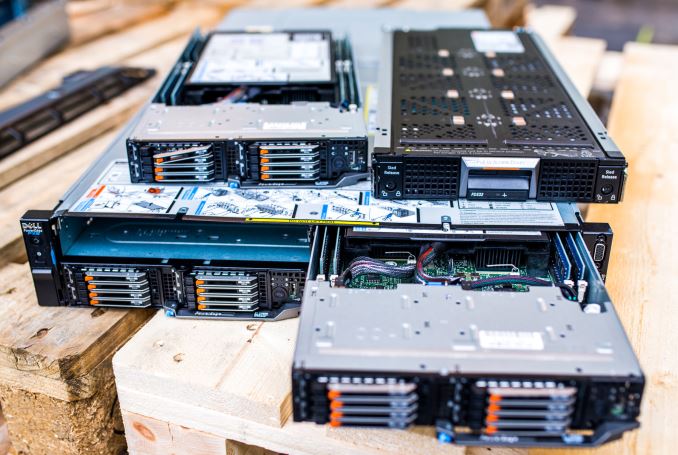The Evolution of HDDs in the Near Future: Speaking with Seagate CTO, Mark Re
by Anton Shilov on July 6, 2016 2:00 PM ESTNew 10K and 15K RPM HDDs Incoming
Hard drives with 10K and 15K spindle speeds are used to store mission-critical applications and data that also require high performance. Such drives typically use a SAS interface with its advantages over SATA/AHCI. Plenty of legacy systems and setups still rely on these fast hard drives, and as a result these systems are not going to be decommissioned in the near future. Nonetheless, the total available market for ultra-fast HDDs with 10K and 15K RPM spindle speeds has shrunk in the recent years due of SSDs. This does not mean that speedy HDDs no longer evolve - Seagate informed us that it is preparing another generation of 10K and 15K RPM HDDs.
Seagate’s new generation of 10K hard drives will not only feature 10K RPM spindle speed as per the name, but also TDMR technology — two readers per head. Those readers will read one track to improve signal to noise ratio and enable higher capacities. Keeping in mind that we are talking about critical storage applications, HDDs with two readers per arm will keep using PMR or SMR recording technology, but eventually the tech could be used for HAMR-based drives.
When it comes to 15K HDDs, Seagate seems to be somewhat more humble or secretive. The company did confirm that it is working on at least one more generation of 15K hard drives. The high-performance SAS deployments are already there and someone needs to serve them, which is where the next-generation 15K HDDs may come in handy. Moreover, SNIA has a long roadmap for SAS towards 24 Gb/s transfer speeds and the year 2020 ahead of it, which is why it is important for Seagate to offer both HDD and SSD solutions for this market. The next generation of 15K HDDs could be the last generation of such hard drives, which is why it will have to offer a balance of features and technologies that Seagate does not want to discuss at this time. Perhaps, not because of competitive reasons, but because it is working with its customers to enable features that they need.
Nonetheless, as new data center platforms arrive, the need for 15K HDDs will inevitably decrease and Seagate understands that. For example, Intel’s latest SSDs for mission-critical applications rely on PCIe bus and NVMe protocol. As a major provider of ultra-high-end Nytro storage accelerators, Seagate will naturally follow market’s trends, but this is a topic to be covered by an SSD-related conversation.











91 Comments
View All Comments
JoeyJoJo123 - Wednesday, July 6, 2016 - link
It's ogre. HDDs are dead. SSDs won.Just give up.
pancakes - Wednesday, July 6, 2016 - link
Not until SSD's offer the same or better capacity/$. SSD's don't make sense for archival data or large amounts of data that does not need to be accessed at higher speeds.ShieTar - Wednesday, July 6, 2016 - link
Well, HDDs barely make sense for archival data either, you still can get tapes at less than a fifth of HDD prices for the same capacity.On the other hand, I think SSD builders do keep an ace in the hole by currently not offering 3.5" SSDs. As soon as the prices for NAND-Chips drop into the right region, they do have the chance to drop the $/GB ratio quickly by just adding a significantly higher number of NAND-Chips to a single controller and DDR-Cache.
HDDs won't vanish within the year, to be sure, but I would somewhat agree to Mr. Ogre in saying that the HDD will be running out of usefullness in the near future.
mkozakewich - Thursday, July 7, 2016 - link
If we get multiple terabytes per square inch, I wonder if tapes can even keep up. Surely some of these advancements (like shingles) can be brought over to tape, too.cm2187 - Wednesday, July 6, 2016 - link
Plus I think you can kiss goodbye your data if you leave an SSD 2 years unpoweredMorawka - Wednesday, July 6, 2016 - link
SSD's under the endurance rating typically last over 10 years. There is even a article here on anandtech about it.tabascosauz - Wednesday, July 6, 2016 - link
SSD data retention != SSD endurance. There is even an article here on Ananadtech about it, go read it.tabascosauz - Wednesday, July 6, 2016 - link
Whoops, didn't read lol. Still, even if SSDs are no problem for client applications, no level headed commercial application requiring long term data retention will choose solid state storage.patrickjp93 - Wednesday, July 6, 2016 - link
Sorry but BS, especially with respect to rebuilding arrays. And with 3DXPoint, solid state data retention will extend to 5x the length the very best magnetic platter is capable of.slyphnier - Friday, July 8, 2016 - link
saying a post BS while you saying BS ?3DXPoint is still new, it have yet to prove it really give 5x better data retention... if already proved then share some legit data.
Although it not much cases that a drive need to be stored offline for longtime AFAIK there still none NAND on consumer grade that have data retention as long as magnetic platter.